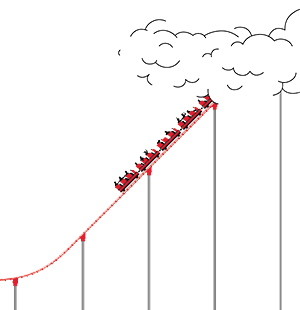All aboard the volatility express

Roula Khalaf, Editor of the FT, selects her favourite stories in this weekly newsletter.
For years this newspaper has been reporting financial markets as a rollercoaster. It was refreshing, then, to find the summer ushered in with a series of stories about how low volatility had become by early June. Yet the general tone in the financial press has been far from soothing. “It’s quiet . . . too quiet”, goes the refrain, followed by the pointed observation that the last time volatility was so low, it was just before the financial crisis began.
There is a commonsense alternative to the idea that this must be the calm before the storm: it’s that no news is good news. So which view is right? Should we treat low volatility as an eerie portent of disaster in the making, or as a sign that the world economy is finally on the right track?
The answer to the question depends on whether we look at financial markets, or at the real economy of goods and services, production and investment.
From a financial perspective, low volatility should indeed make us nervous. That’s the lesson of the late Hyman Minsky. Minsky was once neglected but, since the financial crisis, we are all Minskyites now. Your bluffer’s guide to Minsky is that when things are going well, people become complacent and take too many risks – in particular, the classic leverage risk of borrowing to invest. Calm breeds complacency. Stability is destabilising.
If this all seems a little hysterical right now, perhaps it is – but there are plenty of reasons to worry. US first-quarter growth was disappointing. China’s property market is in trouble. Geopolitics from Iraq to Crimea look shocking. The soothingly low financial volatility of early June looks surreal.
But what happens to the rest of the economy when all is calm? Nick Bloom, a British economist working at Stanford University, has a useful recent research paper on “Fluctuations in Uncertainty” in which he tries to unpick the relationship between economic turbulence and economic trouble.

In 1921, the economist Frank Knight influentially defined risk as the unknown outcome of a known probability distribution such as the toss of a coin or the spin of a roulette wheel; uncertainty, by contrast, was where the probabilities weren’t known at all. Risk is a convenient, tractable concept but uncertainty is a more realistic benchmark for dealing with most economic problems.
Bloom turns to a variety of proxy indicators of both risk and uncertainty: the VIX index, which is a market-based indicator derived from traders’ bets on volatility over the following 30 days; disagreements between economic forecasters; forecasters’ own expressions of uncertainty; newspaper mentions of the word “uncertain” or “uncertainty” and “economy” or “economics”. In all cases, these measures are higher during recessions, although the measured spike in uncertainty is usually when the recession itself is well under way, so this is not much help as a forecasting tool.
What about more fine-grained measures of uncertainty? Bloom looks at the spread between the fastest-growing and fastest-shrinking firms in each industry, and the dispersion between fast-expanding and fast-contracting manufacturing plants in the US.
No matter what the indicator, the story is similar: low volatility, low uncertainty and low dispersion are what happens in good economic times. Recessions are high-volatility, high-uncertainty and high-dispersion events. Low levels of uncertainty may breed complacency but they are also what the economy seems to need. Bloom speculates that, in a vicious circle, uncertainty is both a cause and a consequence of recessions.
. . .
There are some good theoretical reasons why growth goes hand in hand with low levels of uncertainty. Consider a company making a hard-to-reverse decision such as hiring a new permanent member of staff or buying a new factory. If the company was confident of modest growth, it should take the plunge, invest and expand. But if the forecast of modest growth is very uncertain, and growth might be exhilarating or disastrous, then why not wait and find out? If conditions turn out to be right, the factory can always be built later; the worker can always be hired tomorrow.
That makes investment sound like an emotional business but the reasoning above is a matter of pure logic. A computer or a Vulcan would recommend the “wait and see” approach as profit-maximising. Of course, when everybody is waiting, all they will see is further economic depression.
Emotion also matters, of course. Andrew Eggers and Alexander Fouirnaies, two political scientists at the London School of Economics, recently published a working paper titled “Red Zero, Black Zero”, which looked at what happened when growth figures were either fractionally above or fractionally below zero. The difference is of no direct economic consequence in its own right but triggers very different media stories. Eggers and Fouirnaies find that companies don’t worry over the distinction, but consumers do.
All this suggests that low volatility really is good news. It may be seductively dangerous for financial markets. Yet it is what both consumers and producers need to get things back on track. I hope it is no longer necessary to point out that what is worrying for market-watchers is not necessarily bad news for the rest of us.
Tim Harford’s latest book, ‘The Undercover Economist Strikes Back’, is now available in the UK in paperback; Twitter: @TimHarford
Illustration by Harry Haysom
Comments